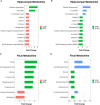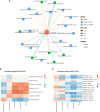919 Syrup Alleviates Postpartum Depression by Modulating the Structure and Metabolism of Gut Microbes and Affecting the Function of the Hippocampal GABA/Glutamate System
- PMID: 34490139
- PMCID: PMC8417790
- DOI: 10.3389/fcimb.2021.694443
919 Syrup Alleviates Postpartum Depression by Modulating the Structure and Metabolism of Gut Microbes and Affecting the Function of the Hippocampal GABA/Glutamate System
Abstract
Postpartum depression (PPD) is a mental disorder that affects pregnant women around the world, with serious consequences for mothers, families, and children. Its pathogenesis remains unclear, and medications for treating PPD that can be used during lactation remain to be identified. 919 syrup (919 TJ) is a Chinese herbal medicine that has been shown to be beneficial in the treatment of postpartum depression in both clinical and experimental studies. The mechanism of action of 919 TJ is unclear. 919 syrup is ingested orally, making the potential interaction between the drug and the gut microbiome impossible to ignore. We therefore hypothesized that 919 syrup could improve the symptoms of postpartum depression by affecting the structure and function of the intestinal flora, thereby altering hippocampal metabolism. We compared changes in hippocampal metabolism, fecal metabolism, and intestinal microflora of control BALB/c mice, mice with induced untreated PPD, and mice with induced PPD treated with 919 TJ, and found that 4-aminobutyric acid (GABA) in the hippocampus corresponded with PPD behaviors. Based on changes in GABA levels, multiple key gut bacterial species (Mucispirillum schaedleri, Bifidobacterium pseudolongum, Desulfovibrio piger, Alloprevotella tannerae, Bacteroides sp.2.1.33B and Prevotella sp. CAG:755) were associated with PPD. Metabolic markers that may represent the function of the intestinal microbiota in mice with PPD were identified (Met-Arg, urocanic acid, thioetheramide-PC, L-pipecolic acid, and linoleoyl ethanolamide). The relationship between these factors is not a simple one-to-one correspondence, but more likely a network of staggered functions. We therefore believe that the composition and function of the entire intestinal flora should be emphasized in research studying the gut and PPD, rather than changes in the abundance of individual bacterial species. The introduction of this concept of "GutBalance" may help clarify the relationship between gut bacteria and systemic disease.
Keywords: Chinese herbal medicine; GABA; gut microbiome; metabonomics; postpartum depression.
Copyright © 2021 Tian, Xing, Zheng and Gao.
Conflict of interest statement
The authors declare that the research was conducted in the absence of any commercial or financial relationships that could be construed as a potential conflict of interest.
Figures





Similar articles
-
Fecal microbiota transplantation confirmed that 919 Syrup reduced the ratio of erucamide to 5-AVAB in hippocampus to alleviate postpartum depression by regulating gut microbes.Front Immunol. 2023 May 24;14:1203015. doi: 10.3389/fimmu.2023.1203015. eCollection 2023. Front Immunol. 2023. PMID: 37292211 Free PMC article.
-
Gut microbiota dysbiosis contributes to depression-like behaviors via hippocampal NLRP3-mediated neuroinflammation in a postpartum depression mouse model.Brain Behav Immun. 2024 Jul;119:220-235. doi: 10.1016/j.bbi.2024.04.002. Epub 2024 Apr 8. Brain Behav Immun. 2024. PMID: 38599497
-
Potential therapeutic effects of Chinese herbal medicine in postpartum depression: Mechanisms and future directions.J Ethnopharmacol. 2024 Apr 24;324:117785. doi: 10.1016/j.jep.2024.117785. Epub 2024 Jan 21. J Ethnopharmacol. 2024. PMID: 38262525 Review.
-
[GABAergic approach of postpartum depression: A translational review of literature].Encephale. 2020 Apr;46(2):123-134. doi: 10.1016/j.encep.2019.09.007. Epub 2019 Nov 22. Encephale. 2020. PMID: 31767256 French.
-
The effect of Poria cocos ethanol extract on the intestinal barrier function and intestinal microbiota in mice with breast cancer.J Ethnopharmacol. 2021 Feb 10;266:113456. doi: 10.1016/j.jep.2020.113456. Epub 2020 Oct 8. J Ethnopharmacol. 2021. PMID: 33039631
Cited by
-
Lactiplantibacillus plantarum GOLDGUT-HNU082 Alleviates CUMS-Induced Depressive-like Behaviors in Mice by Modulating the Gut Microbiota and Neurotransmitter Levels.Foods. 2025 Feb 26;14(5):813. doi: 10.3390/foods14050813. Foods. 2025. PMID: 40077516 Free PMC article.
-
The causal association between gut microbiota and postpartum depression: a two-sample Mendelian randomization study.Front Microbiol. 2024 Sep 2;15:1415237. doi: 10.3389/fmicb.2024.1415237. eCollection 2024. Front Microbiol. 2024. PMID: 39286351 Free PMC article.
-
Fecal microbiota as a predictor of acupuncture responses in patients with postpartum depressive disorder.Front Cell Infect Microbiol. 2023 Nov 20;13:1228940. doi: 10.3389/fcimb.2023.1228940. eCollection 2023. Front Cell Infect Microbiol. 2023. PMID: 38053532 Free PMC article.
-
The Gut Microbiome and Female Health.Biology (Basel). 2022 Nov 21;11(11):1683. doi: 10.3390/biology11111683. Biology (Basel). 2022. PMID: 36421397 Free PMC article. Review.
-
Obesity as Inducer of Cognitive Function Decline via Dysbiosis of Gut Microbiota in Rats.Brain Sci. 2024 Aug 12;14(8):807. doi: 10.3390/brainsci14080807. Brain Sci. 2024. PMID: 39199499 Free PMC article.
References
Publication types
MeSH terms
Substances
Supplementary concepts
LinkOut - more resources
Full Text Sources
Medical
Miscellaneous

